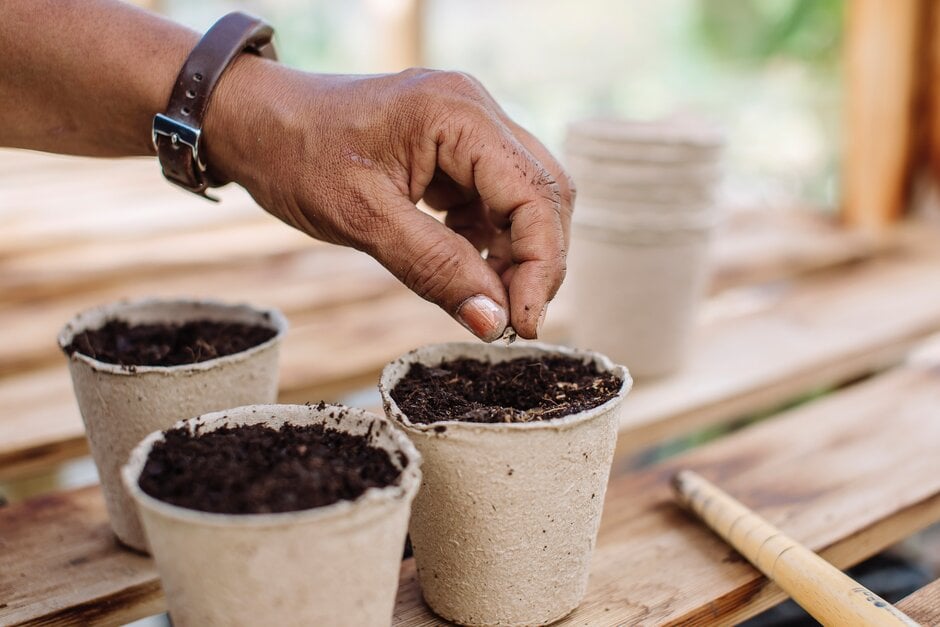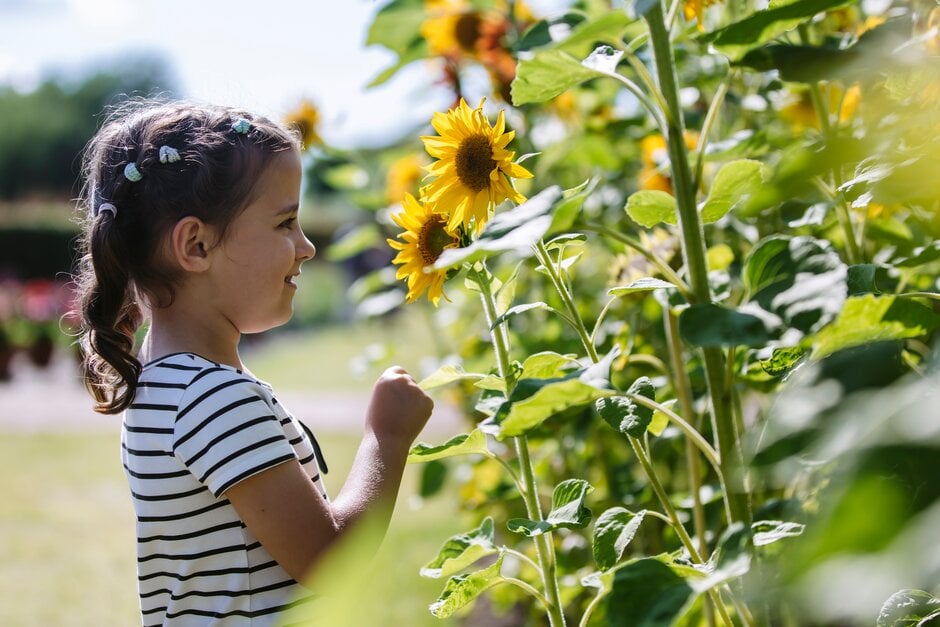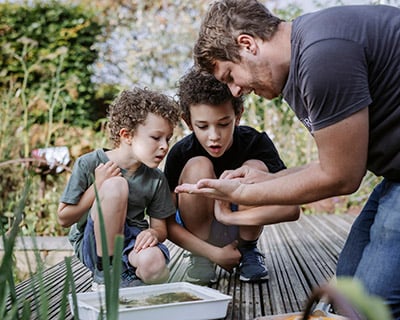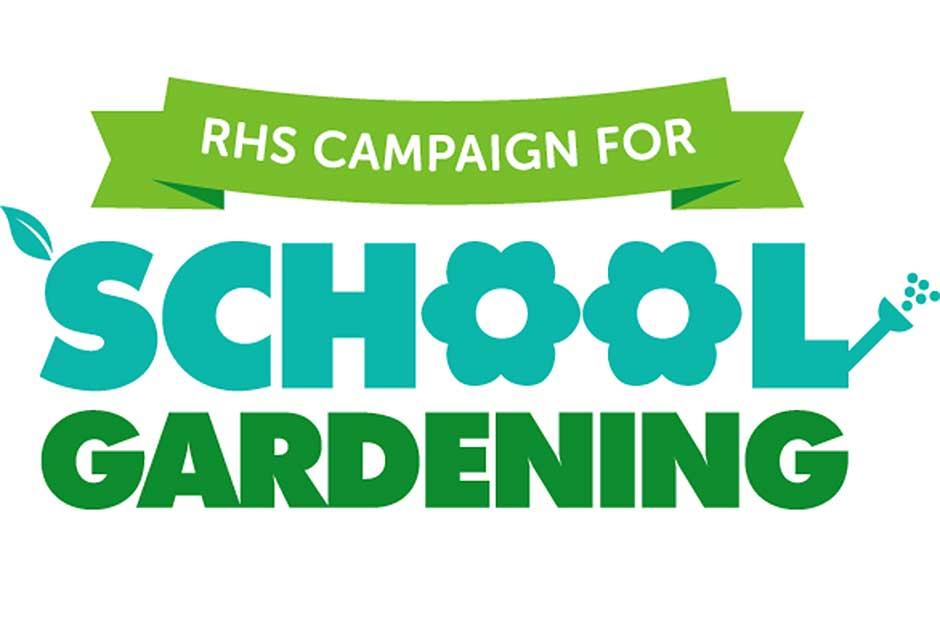It’s widely accepted that getting outdoors even for a small amount of time can enrich our daily lives, and the lives of our children. Nature creates a calming environment for them, which enhances their learning experiences, sparks joy and arouses curiosity.
“Just being in nature is good for everybody’s wellbeing no matter who they are. However, some specific things are helpful for children,” says Karen.
Find out how to get children connecting with nature and benefitting from its restorative powers.
1) Teaches self-regulation
Engaging a child in a gardening activity may cause them to express their feelings in a way they wouldn’t usually. Sometimes sitting down and asking them how they feel can be too direct. It’s a good way of allowing their emotions to just be.
Karen Stocks is a Place2Be trainer and delivers professional qualifications to teachers. Place2Be is a children and young peoples’ mental health charity that works with pupils, families and staff in UK schools. The charity provides a range of mental health and counselling support.
Children often come away from their time spent in green spaces in a better mood. For some, gardening will be a calming experience. For others, it will make them want to sing and dance and run about. It might even make some children cry. Nature offers children the space to connect with themselves so if being in that environment makes them cry, it’s because they need to.
“That’s what nature gives us, that added space to be able to think, feel and connect with ourselves,” says Karen.
2) Allows space for big feelings
Take children on a wellbeing walk. It doesn’t necessarily have to be a long-distance walk, just pick a specific place in your school grounds or local area.
“Ask the children to think about what it is that plants need in order to thrive, and then go deeper and get them to reflect on what they need to thrive. This will get the children to think about what mental health support they might require.
“Wellbeing walks not only teach them that being in nature will make them feel better, but also that it allows for those big feelings and is a space where they can be heard and thought about,” says Karen.
The RHS and Place2Be have worked together to develop our wellbeing walks. The walks focus on perseverance, self-regulation and ways to wellbeing with nature.
“Our wellbeing walks have been geared towards self-regulation, the ability to know how you feel and then decide how you can best express that. It’s also understanding that sometimes we have feelings that are too big and can be overwhelming. Walking slowly, breathing and being in nature can have a calming effect,” says Karen.
3) Encourages individuality
Let children go outside and see what captures their attention. There are many gardening activities and it’s fascinating to see what piques their curiosity. It will give a child a sense of wellbeing through purpose.
“An activity I love doing is meeting a tree. Go out, find a tree, and then meet it. Meeting it means really looking at it; concentrate on the colour, the texture, go and find the leaves, touch the Bark is the outermost layer of woody plants (trees, shrubs and woody climbers). It is several cells thick and provides protection against physical damage, disease and environmental stresses. Bark comes in a wide variety of colours and patterns, and these can help gardeners when identifying plants. The fissures and crevices of bark on older plants also creates valuable habitat for many garden creatures as well as lichens and small plants.
Some children love putting their hands in the mud and getting dirty and others won’t. Allow them to be who they are and to do what they enjoy.
Alison Pryce has been Gardening Lead at Welford Sibbertoft and Sulby Endowed Primary School since September 2023. Plans to transform a bit of unused land at the front of the school into a reading area inspired Alison to start a gardening club.
“I wanted to give the children some gardening experience without it becoming onerous for the teachers. The children are keen to plant flowers to attract wildlife such as birds, bees and butterflies,” says Alison.
4) Develops patience
Planting seeds develops patience, as the children won’t see results immediately. Remind them to check the progress of their seeds regularly and over time, they will start to see the shoots. This creates a sense of wonder.
5) Gives them skills for the future
There is an evidence-based link between plants, nature and wellbeing. Wellbeing has become part of the curriculum, and it’s expected that schools will teach their students about wellbeing and support them. Developed by the RHS and Place2Be, the Roots to Wellbeing activity pack provides teachers with activities to support pupils’ wellbeing.
“Many parents and teachers don’t know where to start with gardening and most schools just don’t have the budget or resources. We want to make gardening in schools as low cost and accessible as possible.
“We focus on growing plants rather than gardening so schools that don’t have any green space can still get involved. No gardening experience is needed, and we focus on how school pupils benefit from engaging with nature,” says Karen.
“It’s relatively easy to link aspects of gardening to the curriculum especially in art and science. In science, year five learn about vegetative reproduction, and year one and year two look at the development of plants and reproduction,” says Alison.
Samantha Howie is a Support for Learning teacher at Buckie Community High School in Moray, Scotland. One of her main remits is doing alternative curriculum activities and looking at how the school can match them to the children’s needs.
“We work to an alternative curriculum, and we have specific slots for gardening activities. For many of our children, learning numeracy and literacy in a traditional way can be challenging, whereas going outside and counting seeds or measuring out soil or water is easier for them.
6) Promotes a healthy lifestyle
Getting active in the garden through gardening or just being in nature is good for children’s physical health, and some of that is because it’s so multi-sensory.
Grow something the children can eat or drink such as mint tea. It’s easy to grow and connects children with where their food comes from. “Sometimes children don’t have an outdoor space at home so it offers them an opportunity to expand their knowledge. Many of our children didn’t know where their food came from so it’s made a big difference to them.
“We’re working towards a holistic approach where the children can grow their own food, cook with it, and share any extra food with the community,” says Samantha.
“There’s nothing like popping fresh peas from a pod in the garden. It’s so rewarding to eat something you’ve seen grow from seed,” says Alison.
7) Improves social skills
Gardening is a gentle and subtle way of getting children to socialise. They can do things together in the garden without it being a highly organised activity. There’s something exciting about experiencing it together, and sometimes even being able to eat what you’ve grown.
“We get the children working outside in groups. They decide what to grow and figure out how to work together. At one point, there was an issue with overwatering and the children solved this problem themselves. Some of our children are artistic and enjoy the design side of things, some enjoy planning and writing lists whereas others are more hands on. It gets them interacting together,” says Samantha.
“Welford Sibbertoft and Sulby Endowed Primary School is small, with only four classes so it does have a good sense of community. The older ones tend to help the younger ones. Everybody knows everybody and the majority are keen on the natural world. It gives them something to work together on,” says Alison.
8) Supports cognitive development
Spending time in nature helps cognitive and child development in general. Outdoor time is part of the curriculum for children under five. A child can become so absorbed in a gardening activity that their concentration levels will increase.
“They’ll do it for much longer than they might have done with another activity because it’s so engaging. We learn best when we’re relaxed so de-stressing activities make us more receptive to learning. Spending time outdoors and in the garden means that our bodies are healthier and more able to function. It improves executive functioning skills like spatial awareness and self-confidence, giving them the confidence to have a go,” says Karen.
“We have children with emotional spectrum disorders, which covers a range of conditions classified as mood disorders, such as autism. Gardening activities such as planting things in soil is difficult for them, but they benefit from the social side of things. Children with autism also like the sensory stimulation, because of that we’ve included wind chimes and a variety of scented plants. Children with ADHD or global development delay (children who take longer to reach certain development milestones than others at their age) are more interested in planting. It helps them focus and speak to people because they can move all the time,” says Samantha.
9) Offers a sense of responsibility
Gardening gives children a sense of achievement. When they feel they’re not good at anything, gardening can improve their confidence and self-esteem. It’s also something outside of the academic system that offers children encouragement. Have clearly identifiable spaces and give them ownership of that area.
“Children like being responsible for the space they are in, it just gives them ownership in a school. Seeing things grow gives them a sense of pride as well. They are taking pride in their community and other people can see it,” says Samantha.
It’s important for children to understand how to care for the world, and that if they’ve planted something they have a responsibility to it. “It’s not just your pets you need to look after, it’s plants as well. You’ve got a duty to find out what the plants you’re growing need and provide for it for them,” says Alison.
10) Educates them on life
For some people, the idea of embarking on gardening is too overwhelming and challenging. But they might like to have a go at growing pea shoots on a windowsill and even that will have a wellbeing benefit. It’s about doing what’s manageable and children need adults that are going to support them with this.
Don’t try and take on a big project or come up with big ideas or schemes. Start small and then as that develops you will naturally build on it. “Before you know it, you might find you’ve got a few pots and are trying to grow different things. It doesn’t have to be successful, just take it on like an experiment,” says Karen.
“There’ll be things that don’t grow; they might get a disease or the slugs come along and eat what you thought was going to be a beautiful sunflower. Alternatively, something might grow through a crack in the pavement that you didn’t plant.”









-763.jpg?width=940&height=626&ext=.jpg)




.jpg?width=940&height=627&ext=.jpg)
